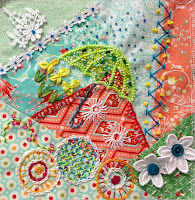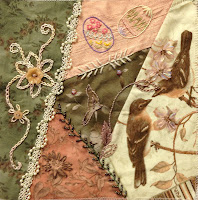Have you noticed the upcoming workshop titled "The Mysteries of Shibori" on our class schedule? Perhaps you are wondering what it is and why we are so excited about it. We have invited Cindy Lohbeck from Hands on Hand Dyeing to tell you a bit about this technique and give you a bit of information about what we will be doing and what some shibori panels can look like when they are finished:
When I
was recently asked to teach a class on Shibori fabric dyeing, my mind and my
dye studio went in to high gear. While I have done fabric dyeing and various
types of Shibori for over 30 years this request triggered a focused study that
kept me fascinated with the possibilities of this workshop.
With the
Indigo Dye & Shibori craze sweeping the design world, it was a good
kick-start for a long overdue addition to my line of fabric dyeing classes.
But where
would I start? Shibori is a very broad, "umbrella" term for a vast
array of techniques. How would I ever narrow down to a workshop what I had
spent years exploring? With its roots in Japan, India and Africa, Shibori can
easily become a long-term creative exploration. Each culture puts their own
"twist" on it (pun intended!) and consequently, the variety of
Shibori methods are endless. While some
of these techniques are deceivingly easy, many are laborious and time
consuming. I know that with the addition of a few modern tools and innovative,
time saving techniques, Shibori can be much more accessible for today's fiber
artists

 Technically,
it is taking a 2 dimensional piece of fabric, and manipulating it into a 3
dimensional fabric "sculpture" by using a variety of tools, folds,
stitches and tucks. These tools, folds, stitches and tucks create
"resists", or areas where dye cannot penetrate. The resulting
patterning possibilities are limitless! I quickly dusted off my bucket of
Shibori tools - things you would hardly associate with fabric dyeing, including
various sizes of marbles, and rubber bands, plumbing pipes, plastic template shapes,
a variety of clamps, and a wide range of thread, string and sinew. Many of
these tools had been put aside for several years while in pursuit of other
creative endeavors, but I could feel the creative juices flowing. I spent the
next 3 months working up samples of each Shibori method I wanted to include in
the workshop, feverishly stitching and binding, folding, clamping, twisting and
wrapping. The samples that came about were fun and inspiring, and spurred me on
to dye some drapery panels for my own home.
Technically,
it is taking a 2 dimensional piece of fabric, and manipulating it into a 3
dimensional fabric "sculpture" by using a variety of tools, folds,
stitches and tucks. These tools, folds, stitches and tucks create
"resists", or areas where dye cannot penetrate. The resulting
patterning possibilities are limitless! I quickly dusted off my bucket of
Shibori tools - things you would hardly associate with fabric dyeing, including
various sizes of marbles, and rubber bands, plumbing pipes, plastic template shapes,
a variety of clamps, and a wide range of thread, string and sinew. Many of
these tools had been put aside for several years while in pursuit of other
creative endeavors, but I could feel the creative juices flowing. I spent the
next 3 months working up samples of each Shibori method I wanted to include in
the workshop, feverishly stitching and binding, folding, clamping, twisting and
wrapping. The samples that came about were fun and inspiring, and spurred me on
to dye some drapery panels for my own home.
As I
explored the various techniques, and considered the best classroom experience,
it became clear that even if I narrowed it down to 7 or 8 styles, it would
still need to be a 2 day experience. The idea of giving a classroom of student
the identical tools, fabric, and fabric manipulation techniques and ample time
for fabric prep on the first day. Day two would begin by introducing several
different dye possibilities for each folding method. This would allow every
student to put their own twist on each technique, whether they chose
traditional Indigo, or a multitude of colors. The diversity of the fabrics that
would "unfold" is intriguing to dream about. One of my favorite examples is this Ne-Maki
style Shibori, otherwise known as ring bound Shibori, is traditionally created
by binding beads or other small spherical objects with thread. In the example pictured
below, I bound the fat quarter very densely with irregular marbles and very
small rubber bands. Even though the fat quarter was reduced to the size of my
fist, this is a fairly fast technique, and
the results are amazing. (While I love playing in buckets of every color
imaginable, I chose to do all of my sampling in traditional Indigo. By keeping
it simple, each participant can visualize her own approach to the project.)
As my
workshop took shape, and I narrowed the number of styles of Shibori down to a
class that gives each participant a diverse and complete experience, I explored
techniques known as Itajime, Kumo, Ne-Maki, Karamatsu, Suji, Nui, and several
variations of Arashi Shibori. Somewhere along the way, I developed my
favorites, and know which styles of Shibori piqued my creative passions. I will
definitely continue my personal experimentation in these styles, beyond the
scope of the classroom environment, and am grateful the workshop has re-ignited
my passion for Shibori. I am excited about the fabrics I envision in my minds
eye, and how I will execute them with the tools and techniques I have acquired.
Most of all, I can't wait to pass the fun on! I know that at least one person
in every workshop will catch the Shibori fever and continue to stitch and bind,
fold, clamp, twisting and wrap their way into some beautiful and unique Shibori
fabrics.
Ready to sign up? You can click on the classes tab of our website -- www.eudoraquiltshop.com for all the details. Hope to see you there!












